1) The Dawn of the Vocationary
2) The Volunteers of Jesus
3) The Slaves of Mary
4) Soldier
5) The Two Religious Orders
6) The Pious Union
7) The Pastor
THE DAWN OF THE VOCATIONARY
On April 30, 1914, Fr. Justin and his group of twelve “fedelissimi” started their first experience of community life in the Russolillo’s home. Fr. Justin’s family was very understanding and cooperative. Mr. Russolillo welcomed them as his own children and soon started making some plans to enlarge Fr. Justin’s apartment for them.
It was a short honeymoon. Aunt Michelina was the cook and Fr. Justin would put on his white apron and serve them at the table. At night, after they had gone to bed, he would mend their torn clothes.
The thrill lasted fifteen days; the bishop visiting the parish church in Soccavo sent for Fr. Justin and ordered him peremptorily to dismiss the children, thus terminating their first experience of community life.
The good father suffered greatly for the foundation; he suffered even more knowing how the news would affect the first members of his religious family. Before returning to Pianura, he visited the Scherillo family; there an aunt to whom he had opened his heart gave him a wooden cross.
Aunt Michelina and the aspirants, unaware of the bishop’s order, waited for Fr. Justin so they could have dinner together. He ate with them and was as
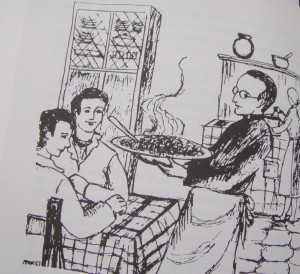
peaceful and jovial as ever. At the end of the dinner he took the cross, and asked everyone to kiss it. Then, with meekness and persuasion, he announced: “We are children of the cross; we must sacrifice our will to the will of the superiors, as Jesus sacrificed his to the will of the Father.”
On July 16, in a plea addressed to St. Pius X, Fr. Justin explained his program in order to obtain approval and encouragement. The Holy See, as usual, acted through the diocesan chancery, and it seemed that the outcome would be rather favorable. The bishop, however, through Msgr. Dell’Isola, who later became Bishop of Cava, renewed his opposition. Why? It was certainly his concern for Fr. Justin’s poor health and concern also for the aspirants, all from very poor families. The bishop’s denial may have been also influenced indirectly by Fr. Justin’s mother who, having three young daughters, was concerned about people gossiping.
The blow was hard! In order to alleviate it, when the bishop went to Pianura to bless the fountains, he asked to see the group of aspirants, and offered to admit one of them to the seminary. Fr. Justin chose Salvatore Polverino, who had already completed grammar school.
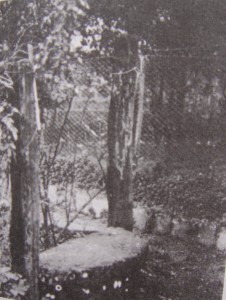
The other aspirants continued to gather around their father and teacher in their native Pianura. Fr. Georgia Mele, S.D.V. used to recall some of the lessons received in the “pagliarella” (hut) in the Russolillo’s garden. “What did you eat today?” Fr. Justin would ask with fatherly care, and George would answer: “Potatoes.”
“And what else,” Fr. Justin would continue.
“Zucchini!” Their good humor alleviated the hardship of instruction for minds that had not been trained to learn and to retain knowledge. Whenever he was invited to participate in formal processions or solemn high Masses, Fr. Justin would graciously decline, declaring, “My mission is to teach young boys.”
VOLUNTEERS OF JESUS
In addition to the small group of aspirants to the priesthood, Fr. Justin also cultivated a larger group called the “Volunteers of Jesus”. They wore tri-colored ribbons on their arms with the image of the Sacred Heart. They were a group of militants, precursors of “Catholic Action.” Their task was to protect public morality, foster and encourage participation in catechetical instruction and receive Communion daily. They would intervene wherever they saw obscene pictures, whenever they heard obscene language, whenever they discovered sinful relations or situations.
The group leaders would commit themselves to wake up the others early in the morning so that they would not miss Holy Communion. Likewise, they would lead them in good order and punctuality to the vespertin liturgies. They also guided them to march orderly and devoutly in the processions. On feast days, Fr. Justin used to shelter them from the dangers of the street, leading them on outings and organizing games in which he was both umpire and pacifier. He used to initiate the older ones into a social apostolate. For example, he wrote a short letter to all the barbers and invited them to his house to agree on a convenient hour for Sunday Mass. He invited the men to perform a section of “popular union of Italian Catholics” in this enterprise; one of his first objectives was to solve the problem of public transportation, which was indispensable for the workers who had to commute to the city every day.
THE SLAVES OF MARY
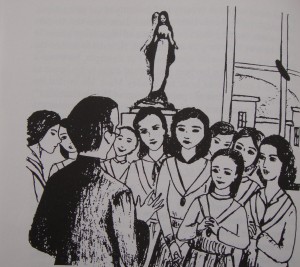
On the eve of his entrance into the Vocationary, George Mele went around saying his good-byes to relatives and friends. At one of his visits, two young ladies, Rachele Marrone and Antonietta Costantino, remarked to him: “Only men must become saints? Tell Fr. Justin that we too wish a program of life to better serve and love the Lord.” Very quickly George went to Fr. Justin with the message and came back with the answer: “Come and you will get it.”
The answer seemed kind of vague to Rachele, so she persisted: “Do I have to go alone or with others?”
Through the same messenger the answer came: “Come with the others.” Miss Marrone had organized a select group of young girls who would gather in her home to pray, work and have some recreation. She was very successful in inspiring and motivating the group through appropriate exhortations and para-liturgies. Each of these young ladies became a catechist for her neighborhood; this is the group that she was referring to. A week later, they were invited for their first meeting with Fr. Justin. The future Sister Rachele was in church, making the Stations of the Cross, when the message-invitation was delivered to her. She was at the fifth station – Simon of Cyrene carrying the cross for Jesus. It seemed that Jesus was inviting her to relieve Fr. Justin of the heavy cross he was carrying.
At the meeting, Fr. Justin invited them to strive for Christian perfection, and he pointed out to them the life of love as the only way to achieve it. Concluding, he said: “Pray that the Lord will send you someone capable of directing you.” Rachele answered for the group: “The Lord has already sent us our guide; you will direct us.”
Fr. Justin accepted their request that he direct this group. After intense spiritual preparation, on August 15, 1914, in his own home before an image of the Blessed Mother, he consecrated as “Slaves of Mary” the first twelve ladies. One of them later commented, “Coming out of that experience I felt like the apostles coming out of the Cenacle after receiving the Holy Spirit.” Each of them was given and accepted the task of multiplying the Slaves of Mary. The growth exceeded every expectation. On March 25, 1915, after a month of intense preparation, the Slaves of Mary mobilized the town of Pianura. On the feast of the Annunciation, they organized groups of people from every neighborhood and at the same hour all these groups started moving in an organized fashion toward the Church of the Holy Rosary. They marched in procession, praying and singing. The various small groups came together, forming a big army that couldn’t fit into the small church; there were more people outside than in. A new wave of spirituality was pervading Pianura.
SOLDIER
At age of twenty, Justin, as a seminarian, had to register for the draft, and as it was customary in Italy, he also had to undergo a physical examination by army doctors. He was not drafted because of his frail health. The following
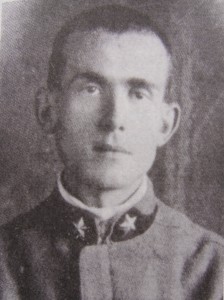
year he underwent another army physical examination and for the same reason he was rejected. Then came the war. All those who had not been drafted for health reason were mobilized on March 14, 1916. Fr. Justin, who was in this category, had to report to the army. The head of the examining commission ironically and maliciously asked him, “How many months of starvation have you undergone to reduce yourself to this condition?” Fr. Justin did not react to the poisonous insinuation but all those who knew him protested for him. He was drafted, and after a short period of training, was assigned to the military hospital of Sacramento. The uniform they gave him was much too large. One of his colleagues, reminiscing, said that it looked like a sack on him.
Fr. Justin’s health could not withstand the rigors of military life. On the day of departure for the front, the commander of the unit convinced that the soldier Russolillo would not have made it to the station under the heavy load of the backpack hired a young boy who was very happy to march next to the soldier carrying his pack. A few soldiers complained about the special privilege given to Fr. Justin, but the majority of them felt sorry for that skinny priest. One of the soldiers on the first march was overheard saying, “If I should ever decide to go to confession, I would go only to him.”
With the military unit Fr. Justin experienced some very hectic days but also days of peaceful rest. On June 9, 1918, he wrote: “I am an assistant to a doctor in a section with three beds and no sick people,” on August 5, 1918, he wrote: “I am so busy that you could not believe it. There are one hundred beds here and I am the only attendant.”
The military bishop, having come to know the charity, abnegation and industry with which Justin was fulfilling his duty, gave him a solemn and public recognition.
Certainly, Fr. Justin wasn’t happy to join the army, even though he loved Italy very much.
He was greatly grieved by the profanities of the soldiers around him. Many times he would go to bed early so he would not have to listen to their blasphemies and foul language, but some of the soldiers would purposely raise their voices and abound in profanities, knowing well that this would bother the poor priest. He was also grieved realizing that the war would delay the realization of his mission. “Oh, how I cherish the sweet hope of returning for good to my ministry and to the beautiful school which also is a part of my priestly ministry. Blessed be God forever and ever,” he wrote in a letter on August 5 1918.
There were several encouragements and occasions for Fr. Justin to get out of the army. Fr. Angelo Ziccardi, SJ., being with Fr. Justin at weapons training in Pozzuoli, would very willingly shoot in place of Fr. Justin at target practice. Fr. Justin didn’t even want to touch the gun. After marching back to the barracks, the same priest, seeing Fr. Justin changing his tee shirt, was astonished to see that Justin was such a frail human being. He advised the servant of God to go for sick call and realized that Justin was unwilling because he knew that the army doctor would easily descend into profanities and blasphemies. Fr. Ziccardi, who was a professor of philosophy at the Pontifical Seminary, insisted, “Actiones sunt suppositorm.” “You are not accountable for the outbursts of that crazy guy.” Fr. Justin was convinced and he reported to the doctor for a checkup. When the doctor saw him naked, a walking skeleton, he bust out with the filthiest expressions against those who drafted that “spider”; the doctor sent him home, recommending that he be discharged at once. Unfortunately, he was not discharged but was called back.
Another opportunity came when a special law allowed soldiers with a bachelor degree to become Quartermaster Officers after passing physical examinations. Fr. Justin tried to take advantage of this new law but was rejected by the medical commission because he was too weak. Naturally, there was no logic in the decision of the medical examiners. If he was unable to withstand this light work, how could he withstand the much heavier labor he was already engaged in? His relatives appealed to her majesty Queen Elena to intervene and correct the injustice. Consequently, he was called to Florence for another physical examination, and this time, he was dismissed from the army on account of poor health, when the war was about to end.
A short note in Fr. Justin’s spiritual diary, written only a few months before his death, may give us an idea of how he felt about his military service: “9-30-54. Anniversary of my liberation from military service.”
THE TWO RELIGIOUS ORDERS
The unpleasant experience of military life could not force Fr. Justin to neglect the groups of people that he was guiding. As long as Fr. Justin was in Naples, the “fedelissimi” bravely walked from Pianura so that they could serve his Mass and could continue to receive Latin classes and exhortations on the practice of virtues. It was Fr. Justin’s ideal and dream to make of every employee, professional, politician and head of state a true religious of God; he dreamed of families, cities and countries becoming true religious of God according to Jesus Christ. Fr. Justin combined words and actions. One day, he went to a barber shop to get a haircut. At the end, the barber sprayed and meticulously combed his hair. Fr. Justin let him do it but afterward, as soon as he walked out of the shop, with his hands he ruffled up his hair again. “What a sin!” exclaimed the future Fr. Saggiomo, “It looked so good.”
“Vanity is sin,” Fr. Justin corrected him.
From time to time even the young ladies who had started the journey toward perfection would arrive in groups at Vomero where he would say Mass for them in the Convent of the Franciscan Missionaries of Mary and exhort them to persevere in their holy ideal. Often he was given leave to go home. The first time he went to Pianura in his military uniform, he was surrounded by many friends who were both curious and mortified at seeing him in that attire. Large groups of people always formed by his house to celebrate his homecoming. Naturally, the first and the noisiest were always the “fedelissimi,” Often he would celebrate Mass at 4:00 a.m. before returning to the army base, and the boys and girls would crowd the church at 3:00 a.m.
He was home when he heard the news of the defeat at Caporetto; the troops had been decimated, humiliated and needed reinforcement. Then, he had to go. The “fedelissimi” found out the hour of his departure and decided to be there both for their own and his consolation, bringing gifts, bags of food for the long journey. That afternoon, Giovannina, Fr. Justin’s sister arriving at the house of aunt Michelina, found her petrified by grief, surrounded by the boys in tears and the various bags of food; they had arrived too late for the departure.
From the front he would write letters addressed to the “Souls of Pianura who are militating toward the heavenly country.” During that time he wrote and sent a handwritten booklet of Devotions for the month of May.
Unexpected fruit of this long agony caused by the war was the project of founding the Vocationist Sisters. Fr. Justin had always been thinking about the Vocationist Fathers so much that when Fr. Fancesco Sepe, S.D.V., wanted to know about the origins of the community, he answered, “I cannot be precise about the time, but I can assure you that the thought was born with me.” On another occasion, Fr. Justin said, “I could show you the seminary room where I made a vow to found the congregation.”
When the Vocationist Sisters later on went to work in the seminary of Pozzuoli, Fr. Justin confided to them, “I am very pleased that they gave you the rooms in which I made a vow of founding the congregation.” This clearly indicates that his dream had become a duty, and anticipating the possible difficulties, he had committed himself to its realization with a vow.
He had not thought of founding a religious community for women; in fact, he had explicitly renounced such a project. The pious Christian ladies, he thought should have supported the Vocationary and the work of the Vocationist Fathers without being “religious.” As a matter of fact, when Bishop Farina of Troia, founder of the Oblate Sisters of the Sacred Heart of Jesus, visited him in Pianura, he jokingly asked: “Who has perverted you to found the sisters?” The two had discussed the issue several times together; on the example of St. Ignatius he had always been against founding a religious community of Sisters. In Mestre, he saw the sisters of St. Bartolomea Capitanio working hard in the hospital and he convinced himself that in order to solve the logistic problems that would face the religious community of men, it was necessary to have a religious community of women. Mary and Joseph are needed to raise the Baby Jesus who lives in those who are called to the priesthood. During one of his visits to Pianura, while he was in the army, he announced: “Non est bonum hominem esse solum,” which means: “It is not good for man to be alone.”
From Florence he wrote to the Ferraro Sisters, “I am thinking of you for a project that we want to realize together in order to please God.” More explicitly he wrote to his sister Giovannina, “If God wants to use me for a religious congregation of sisters (as I have in mind) you could be the first or one of the first.”
THE PIOUS UNION
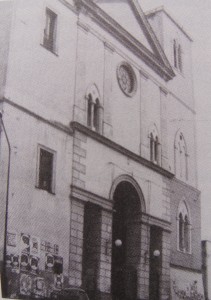
With the approval of the bishop and the permission of the pastor, the Pious Union was officially established on February 1,1919; its goal were to promote religious education of children, the missionary formation of the faithful, and to cooperate with the work of the Society of Divine Vocations, still in its embryonic state. The parish church was crowded; the liturgical celebration of St. Ignatius Martyr offered the inspiration for the exhortation: “To be host with the Host.” He divided the members of the Pious Union into three different categories: the “Effectives,” who were given a ribbon of the liturgical color as their emblem, the “Aspirants,” who were given a lace of the liturgical color, and the “Aggregates,” married women, who were given a cockade of the liturgical color. The Miraculous Medal completed the three distinctive emblems.
Throughout his life, Fr. Justin kept fostering spirituality in complete harmony with the liturgy; he thought that the various colors – white, red, green and purple – remind us of and nourish the official spirituality that flows from the sacrifice of the cross. The Pious Union was given the task of establishing centers of prayer in every section of the town in preparation for the consecration to the Sacred Heart. The Pious Union and the fervor it caused kept increasing every day. The young priest would intervene only for the final arrangements. Colorful decorations, lights and religious songs gave special vitality and vibration to every street until late at night. Every street or section of it consecrated to the Sacred Heart was given a special religious name, such as “Of the Sacred Heart,” or “Of the Seven Spirits Assisting at the Throne of God…”
Fr. Justin elected twelve members of the Pious Union from the group of the “Effectives,” and with the blessing of the pastors, sent them two by two for the apostolate into the various suburbs of Pianura. Parents gave maximum freedom to their daughters on account of the high esteem they had for the young priest; they knew that their daughters were safe when they were following Fr. Justin to Masseria Grande, where he was chaplain, or to Torre Caracciolo. These young ladies wanted to make sure that they would not miss any of his sermons. The young men in town were not so happy about this excess of devotion. Even Fr. Justin’s brothers, maybe instigated by the local clergy, showed some reservations. Francesco, the older brother, felt a need to warn his mother. “Mother, please watch after Justin!” They did not doubt him, they were only afraid that he might get into trouble with some unscrupulous young men; they did not need to worry, however – the candor of the pious priest dispersed every shadow of doubt.
THE PASTOR
Above the parish church of Pianura there were some large rooms; the young ladies of the Pious Union used to gather there to pray and to work for vocations. Everything was going smoothly until the pastor’s sister started to influence her brother against them. There followed moments of tension and hints of eviction.
Fr. Justin kept asking the young ladies to pray a lot. He was not much distressed by the fact that he had to look for another place as he was distressed by the unbending opposition of the bishop to community life. In July 1920, Bishop Farina invited him to the city of Troia and offered him the position of director of the diocesan seminary plus a convent where he could freely develop his work for vocations.
In the meantime, the Bishop of Pozzuoli had been promoted to head the Archdiocese of Naples; but Bishop Ragosta, who had been appointed apostolic administrator of the diocese of Pozzuoli, did not want to lose Fr. Justin. The providence of God intervened through an unforeseen and painful happening: suddenly, the pastor, Fr. Giosue Scotto, died of pneumonia. Soon, a self – appointed committee was and one morning the city of Pianura was seen decorated by multicolored billboards proclaiming, “Long live the Pope. Long live the Bishop. Long live Fr. Justin, pastor.” Fr. Justin did not appreciate the unrefrained zeal and was grieved by the episode. He had no intention of seeking the pastorship, both because he wanted to maintain the necessary freedom for the realization of his plans and out of respect for his Confirmation sponsors, Fr. Salvatore Di Fusco, who was aspiring to that position.
The bishop saw the solution to the “Russolillo Case” in convincing Fr. Justin to seek the pastorship of the vacant parish; he sent Msgr. Causa to Pianura to talk and convince Fr. Justin to apply for the pastorship. His affirmative decision was welcomed with unprecedented expressions of joy. On September 20, 1920, after having spent a week in spiritual retreat with the Dominican Fathers, Fr. Justin was installed as pastor of St. Georgio’s parish in Pianura. Fr. Justin ascended the pulpit and began his pastorship announcing his motto, which was also printed on the holy cards prepared for the occasion: “The son of Man did not come to be served but to serve and give his life for the ransom of many.”
After the ceremony, a large crowd escorted him home. Present at the installation were, among others, Jesuits and Camaldolesi priests –from both active and contemplative life – representing the happy union that Fr. Justin would realize: “Contemplation in action and action for contemplation.”
Source:
Caputo, Fr. Louis, SDV. A Servant of the Divine Vocations: Fr. Justin Russolillo. Copyright 1998. U.S.A. Pg. 23 – 40.
